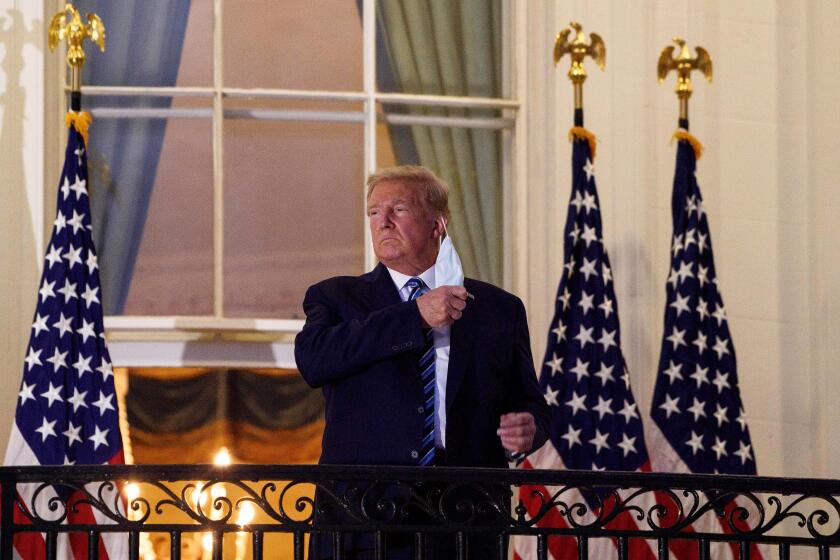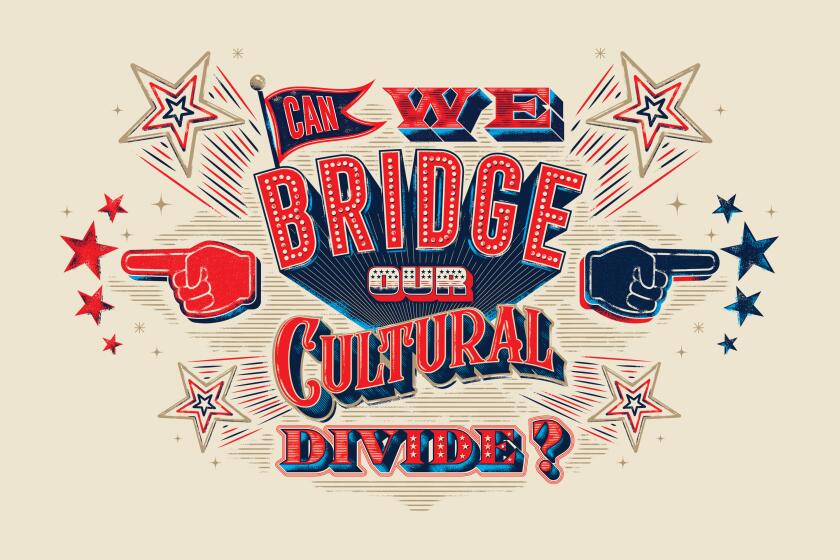Column: Feeling Election 2020 anxiety? Tap into painter Judith Bernstein’s lady rage
- Share via
Nothing channels the vibe of our political moment quite like large canvases of toxic masculinity. (Just like cable news!) Except in this version, phalluses rendered in bright, comic book colors have met their match: toothy vaginas that appear to devour them. Plus, it’s all visible under blacklight, making this viewing experience less Fox News and more vertiginous funhouse of pesky dongs.
Welcome to “Hot Hands,” Judith Bernstein’s bawdy, funny, righteously exasperated solo exhibition at the Box gallery in downtown Los Angeles. It’s all the steroid madness of our political system, captured through a lens of acidic lady rage.
And in the middle of an election that has left me despondent (seriously, how much cash should I be stockpiling for the downfall of democracy?), it feels like a call to arms — one that involves plenty of angrily scrawled genitals and buckets of bathroom humor. When our looming conflict erupts, I will fight in the Army of Judith Bernstein.
As Bernstein told T: The New York Times Style Magazine during a studio visit in 2017: “My work is sexual. My work is political. And my work is feminist. It has visual impact. It’s fun. But it’s dead serious.”
Dead serious about calling the powerful to the mat for their abuses.
“Hot Hands” brings together recent works from various series by the artist, including her anti-Donald Trump paintings, made in the first few years of the Trump administration, which feature a presidential figure called “Trumpenschlong” made out of male genitalia, at times in penile one-upmanship with Vladimir Putin and Kim Jong Un.
There is new work too. Such as a painting titled “Gaslighting (Red)” that features a field of battling pudenda in screaming shades of crimson red, blue and orange under fluorescent yellow letters. Another canvas, “Crown,” painted this year, features various plays on the word “crown” and the related “corona.” It’s the visual equivalent of a panicked Cardi B shouting “Coronavirus! S— is real!”
Needless to say, the bulk of Bernstein’s work can’t be shown in this piece because my employer allows only for coverage of metaphorical johnson.
If it all sounds like the sort of scatological graffiti you’d find in a men’s bathroom, well, that’s exactly the point.
Bernstein, who was born in New Jersey but has lived in New York’s Chinatown for more than half a century, became inspired by the possibility of bathroom graffiti as a student at Yale University in the 1960s. In 1967, she read a story in the New York Times that noted that the title of Edward Albee’s “Who’s Afraid of Virginia Woolf?” came from a phrase he found on the walls of a pub bathroom.
“Graffiti, you think, by the way, is actually very superficial — it’s not,” Bernstein once told Artforum. “It comes from a subtext. It comes from the inner subconscious.”
Graffiti also serves as an important voice for those who may not have access to official platforms. (For example: How do scholars know what women in ancient Rome may have been thinking about their condition? The answer partly lies in graffiti.)
For Bernstein, the ethos of graffiti, with its immediacy and its crude declarations, often in shouty capital letters and featuring coarse drawings of male members, became fundamental to her work.
Toxic individualism has led the U.S. to have one of the highest COVID-19 death rates in the world. It’s time for a new national myth.
A series of anti-Vietnam War paintings from the 1960s feature male members amid inappropriate-to-print graffiti critiquing Uncle Sam and the war. She created a figure of a penis-headed businessman she dubbed “Cockman,” who served as a stand-in for corporate and political power. She began signing her name in large, hastily scrawled letters — in the same unstylized way you might carve your name into a bathroom stall. (Some of these early works were shown at the Box in 2011)
Donald Trump. Joe Biden. And a nation wounded by a pandemic plus the chronic diseases of racism, inequality, rabid partisanship. Artists must bear witness and aid the healing.
In the 1970s, Bernstein followed up with a series of expressionistic charcoal drawings of screws that sexualized, in aggressive ways, that common piece of household hardware. The now-defunct Boyle Heights gallery Venus featured a massive mural of one of these on the exterior of its building in a 2017 show whose name I can’t reprint (unless, perhaps, Trump is caught on tape saying it).
At a time in which our political system has been relentlessly debased by a president who has used his position to sustain his hotel properties, whose children have made millions overseas as he attacks the business ethics of his opponent’s son, and who for weeks has been actively working to undermine the democratic process, Bernstein’s paintings feel like the needed counter.
They are an artistic middle finger, a deep-throated laugh in the face of authoritarian power grabs and ultimately a rallying cry — that come what may, we ain’t going quietly.
Judith Bernstein — "Hot Hands"
Where: The Box, 805 Traction Ave., Los Angeles
When: Through Dec. 19, timed visits are by appointment via the website
Info: theboxla.com
Whether Trump or Biden wins, difficult repair works lies ahead after election 2020. Can we bridge our cultural divide?
More to Read
The biggest entertainment stories
Get our big stories about Hollywood, film, television, music, arts, culture and more right in your inbox as soon as they publish.
You may occasionally receive promotional content from the Los Angeles Times.













